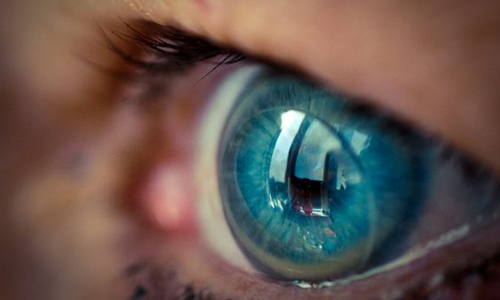Researchers describe receiver-free, glucose-sensing contact lens
January 26, 2018
Source: MobiHealthNews
 739
739

A team of South Korean researchers is the latest to tout a smart, glucose-sensing contact lens. In a research article published today in Science Advances, the team described soft lenses carrying a tiny LED light that automatically turns off in the event of high glucose levels, as well as their efforts to test the lens in vivo.
“The reliability and stability of soft contact lenses have been studied extensively, and significant advances have been made to minimize irritation of the eye to maximize the user’s comfort,” the researchers wrote. “The user’s tears can be collected in the contact lens by completely natural means, such as normal secretion and blinking, and used to assess various biomarkers found in the blood, such as glucose, cholesterol, sodium ions, and potassium ions. Thus, lens equipped with sensors can provide noninvasive methods to continuously detect metabolites in tears.”
Efforts to develop a glucose-sensing contact lens have made waves in the past, with the most notable effort announced by Google and Novartis announced in 2014. The project proved to be difficult, however, with a Novartis representative admitting to Reuters in late 2016 that plans for human tests of the lenses were still up in the air.
Any successful execution of these types of wearables is no small feat, as a number of features often necessary for the construction of a smart contact lens often limit its practicality. These challenges, according to the Korean researchers, include the need for unblocked vision, difficulties with the curved shape of a contact lens, the possibility that integrated electronics could irritate or damage the eye, and the need for bulky external signal receivers.
“For all the reasons stated above, we have introduced an unconventional approach for the fabrication of a soft, smart contact lens where all of the electronic components are designed with normal usability in mind,” they wrote. “For example, the wearer’s view will not be obstructed because the contact lenses are made of transparent nanomaterials. In addition, these lenses provide superb reliability because they can undergo the mechanical deformations required to fit them into the soft lens without damage. In addition, display pixels integrated in the smart contact lens allow access to real-time sensing data to eliminate the need for additional measurement equipment.”
The team’s lens includes a glucose sensor, wireless power transfer circuit, and display able to react to real-time sensing data. Using a graphene sensor, the display will turn off once glucose levels in the wearer’s tear fluid exceed a certain threshold. This alerts to the wearer or anyone looking at them of a potential hyperglycemic episode.
The researchers tested the functionality of their creation by placing the lens onto the eye of a live rabbit. They reported accurate performance by the lens, stable placement with blinks, and no signs of abnormal behavior from the rabbit.
“The in vivo tests using a live rabbit, including the monitoring of the temperature change on the rabbit’s eye, provided the substantial promise of future smart contact lenses for noninvasive healthcare monitoring using human eyes and tears,” they concluded.
Google and Novartis may have been the biggest names with a glucose-sensing contact lens history, but they’re hardly alone. In 2016, Medella Health announced $1.4 million in funding for their own lens, which would transmit readings to a mobile device. More recently, another team of researchers also described their efforts to bring non-blood glucose monitoring to contact lenses or other wearables in the journal ACS Nano. This group described an ultra-thin, flexible sensor able to measure levels within tears and sweat that could potentially be incorporated into contact lenses or placed on the backs of watches.
By DduRead more on
- Things to Know before Buying Newborn Baby Incubators March 31, 2022
- Highly Resistant Food Poisoning Bug Responds to Antibiotics September 6, 2018
- 4 Wearable ECGs EKGs Monitor and Their Features September 5, 2018
- Smartphone Based Diagnosis to Identify Mosquitoes Transmitting Infection September 5, 2018
- 3 Natural Plant Extracts Manufacturers on Drugdu.com September 4, 2018
your submission has already been received.
OK
Subscribe
Please enter a valid Email address!
Submit
The most relevant industry news & insight will be sent to you every two weeks.



